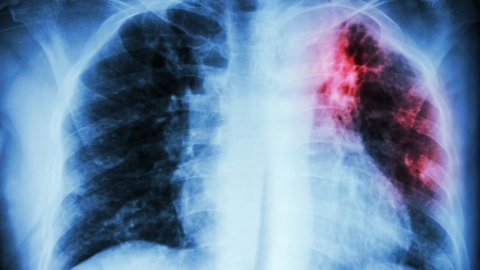Conditions Legionnaires’ disease (legionellosis)
ICD codes: A48.1 A48.2 What are ICD codes?
Legionnaires’ disease is a respiratory disease caused by Legionella bacteria in water. Infection occurs when microscopic water droplets (aerosols) containing the pathogens are inhaled. The symptoms range from flu-like symptoms to severe pneumonia.
At a glance
- Legionnaires’ disease is a respiratory disease caused by (Legionella) bacteria. It can cause flu-like symptoms but also severe pneumonia.
- Legionella bacteria can multiply in stagnant, warm water. Potential sources of infection include showers or jacuzzis with poorly maintained water systems.
- Infection occurs when microscopic water droplets (aerosols) containing the pathogens are inhaled.
- Elderly people and those with immune deficiencies or chronic illnesses are at higher risk of contracting the condition.
- If pneumonia develops, patients usually require antibiotic treatment in hospital.
Note: The information in this article cannot and should not replace a medical consultation and must not be used for self-diagnosis or treatment.

What is Legionnaires’ disease?
Legionnaires’ disease (legionellosis) is a bacterial respiratory infection that may or may not involve pneumonia.
It is caused by Legionella bacteria. These bacteria can multiply in stagnant water and at warm temperatures, for example in water pipes. They enter the airways in the form of microscopic water droplets (aerosols).
Older people, people who are chronically ill and people with an immune deficiency are most at risk of becoming infected with Legionnaires’ disease. Smoking also increases the likelihood of becoming infected.
The term Legionnaires’ disease also refers to pneumonia caused by Legionella bacteria. It should be treated with antibiotics and hospitalization is usually necessary.
There is also a mild form of legionellosis known as Pontiac fever. This is similar to a flu infection and usually clears up by itself within a few days.
Interesting fact: Legionnaires’ disease is named after a convention held by the “American Legion” of war veterans in 1976. Large numbers of older people fell ill with severe pneumonia; the source of the infection was the contaminated air conditioning plant at the convention hotel.
What are the symptoms of Legionnaires’ disease?
Infection with Legionella bacteria can be associated with symptoms similar to a flu infection. In this case, it is known as Pontiac fever. The symptoms usually appear within 5 hours to 3 days of infection. Those affected usually have
- a dry cough
- a headache
- aching limbs
If the Legionella bacteria cause pneumonia, this is known as Legionnaires’ disease and the symptoms are far more serious. They appear within 2 to 10 days of infection and typically include the following:
- sudden high temperature and shivering
- severe feeling of discomfort
- shortage of breath (dyspnea)
- coughing and sputum
Further symptoms such as stomach pain, diarrhea and confusion are also possible.
How is Legionella passed on?
Legionnaires’ disease is caused by infection with Legionella bacteria. The bacteria are transmitted via aerosols, mists of microscopic water droplets containing the pathogen, and enter the airways when inhaled.
Legionella bacteria can multiply in water systems or pipes if the water remains in them for a long time and has a temperature of between 25°C and 45°C. Potential sources of infection include taps, showers, jacuzzis, humidifiers and cooling systems.
Older and poorly maintained hot water systems in particular provide favorable conditions for the bacteria to grow and form a “biofilm” of slime in the water pipes.
In addition to infection via aerosols, in rare cases, infection is also possible if water containing the pathogens accidentally enters the windpipe instead of the esophagus when swallowed. However there is no risk of infection when drinking the water in the normal way as Legionella bacteria are killed by gastric acid in the stomach. Infection from person-to-person is also almost unheard of. So people who have been infected do not pass the infection on to others.
How common is Legionnaires’ disease and who does it mainly affect?
In recent years, over 2,000 cases of Legionnaires’ disease have been reported in Germany each year. Within Europe, 4.5% of all cases of pneumonia where infection occurred outside a hospital were caused by Legionella bacteria. However, it should be assumed that not everyone with pneumonia is tested for Legionella, so the actual number of cases of infection will be higher.
Most cases of Legionnaires’ disease only affect one person, but minor outbreaks with a single source of infection are occasionally reported, for example in hotels or on cruise ships. More cases of Legionnaires’ disease (legionellosis) occur in summer and autumn than in winter and spring.
The people most at risk of Legionnaires’ disease include:
- elderly people
- people with immune deficiencies
- people with diabetes and chronic heart disease or pulmonary disorders
- smokers
Men are two to three times more likely to be infected than women.
How can Legionnaires’ disease be prevented?
It is particularly important to prevent Legionella bacteria from reproducing in water systems. The proper construction and appropriate maintenance of water systems are of general importance.
Water pipes in residential buildings should be used regularly. Basins full of stagnant water (reservoirs) as well as dead-end pipes resulting, for instance, from disconnecting a sink or moving a basin, should be avoided.
Legionella bacteria struggle to multiply when temperatures fall below 20 degrees or rise above 55 degrees; they die at temperatures above 60 degrees. The temperature control on central boilers in residential properties should therefore be set to a minimum of 60 degrees. The water should have a minimum temperature of 55°C throughout the hot water pipe system. Cold water pipes should be insulated so that the water in them does not heat up, for example due to higher temperatures in summer.
Devices that atomize water, producing aerosols, should be regularly cleaned and stored in a dry condition. Examples of such devices include humidifiers.
There is no vaccination against Legionella.
Important: The temperature in the hot water system should never be reduced to save energy. So as not to risk Legionella growth, the water should have a minimum temperature of 55°C throughout all hot water pipes.
How is Legionnaires’ disease diagnosed?
Doctors will ask the patient questions and perform physical examinations in order to diagnose Legionnaires’ disease (legionellosis). If pneumonia is suspected, the lungs are sometimes X-rayed. However, these scans alone are unable to definitively determine whether a patient has Legionnaires’ disease.
To definitively diagnose an infection with Legionella, several laboratory methods are therefore used. In many cases, Legionella can be detected using rapid urine tests. It is also possible to take sputum (phlegm) and use it to grow a culture in a laboratory on special growth media. A “PCR” test can also be used to detect Legionella DNA in the sputum.
How is Legionnaires’ disease treated?
Legionnaires’ disease with pneumonia should be treated with bacteria-inhibiting antibiotics as quickly as possible. Treatment in hospital is often necessary. In many cases, fluoroquinolone antibiotics such as levofloxacin or moxifloxacin are used. Alternatively, macrolide antibiotics, such as azithromycin or clarithromycin, can be prescribed. Doctors often administer these intravenously.
Treatment takes 1 to 2 weeks, sometimes longer. If the treatment is effective, most people make a full recovery from Legionnaires’ disease (legionellosis) with pneumonia. In up to 10% of cases, however, the infection is fatal. This makes it particularly important to start the treatment as quickly as possible.
People with Pontiac fever do not need to be treated with antibiotics.
- Berufsverband deutscher Internistinnen und Internisten (BDI). Legionärskrankheit. Aufgerufen am 12.09.2024.
- Bundeszentrale für gesundheitliche Aufklärung (BZgA). Erregersteckbrief: Legionellen. Auf: infektionsschutz.de. Aufgerufen am 12.09.2024.
- Deutsche Gesellschaft für Pneumologie und Beatmungsmedizin e.V. (DGP), Deutsche Gesellschaft für Infektiologie e.V. (DGI), Paul-Ehrlich-Gesellschaft für Chemotherapie e.V. (PEG) und andere. Behandlung von erwachsenen Patienten mit ambulant erworbener Pneumonie und Prävention – Update 2021. S3-Leitlinie. Aufgerufen am 12.09.2024.
- Robert Koch-Institut (RKI). RKI-Ratgeber: Legionellose. Aufgerufen am 12.09.2024.
- Robert Koch-Institut (RKI). SurvStat@RKI 2.0. Web-basierte Abfrage der Meldedaten gemäß Infektionsschutzgesetz (IfSG). Aufgerufen am 12.09.2024.
- Umweltbundesamt. Rund um das Trinkwasser. Aufgerufen am 12.09.2024.
Reviewed by the German Legionella Reference Laboratory.
As at:





